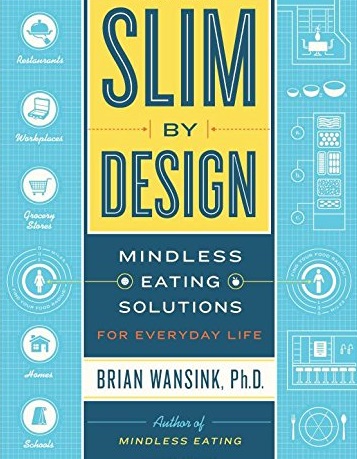Filed in
R ,
SJDM
 Subscribe
Subscribe to Decision Science News by Email (one email per week, easy unsubscribe)
WHERE THE SJDM MEMBERS ARE FROM IN THE WORLD
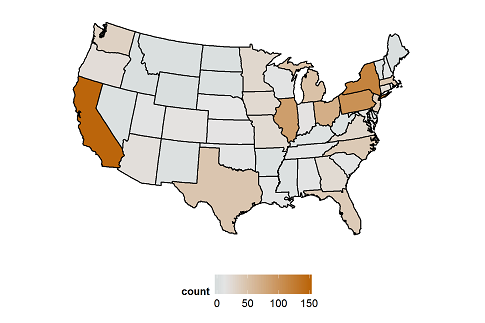
Last week, we looked at where the Society for Judgment and Decision Making members were from in terms of academic areas. This week we look at where they’re from geographically.
To start, we note that most members (1195/1714 or 70%) are from the USA.
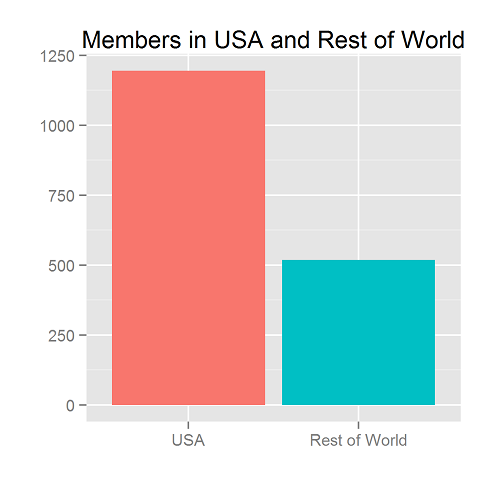
Inside the USA, there are members in 45 states, as seen at the top of the page. The states with more than 5 members are these:
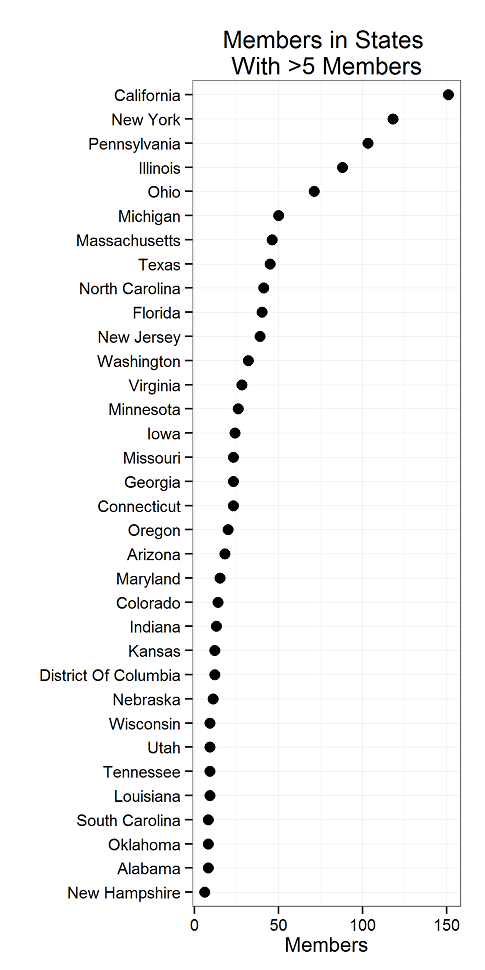
Outside the US, we have members in North America, Europe, Asia, Oceania, South America and Africa.
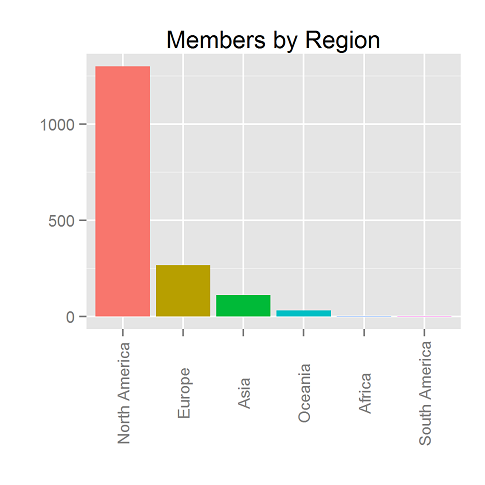
And those regions comprise 39 countries. Here are the countries with more than 5 members.
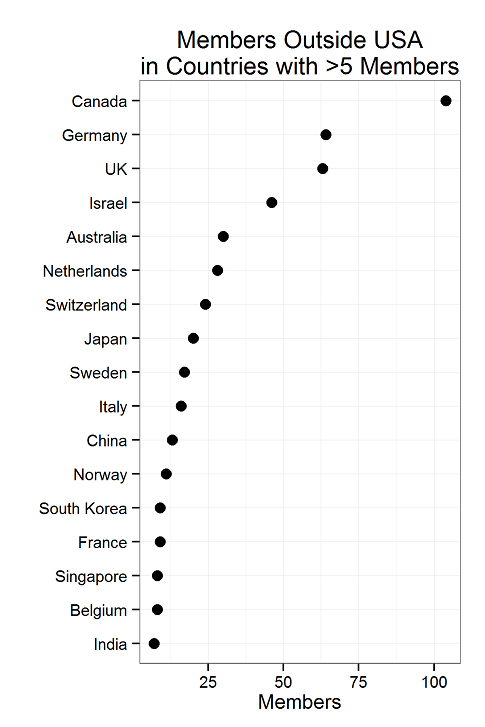
Now, you’re probably wanting to reproduce these graphs. Or, if you’re like most people, you aren’t.
You’ll need directory.csv.gz, state_table.csv.gz, and regions.csv.gz. And the code below.
H/T to @winston_chang’s R Graphics Cookbook, from which I borrowed a code snippet or two.
Filed in
R ,
SJDM
 Subscribe
Subscribe to Decision Science News by Email (one email per week, easy unsubscribe)
ANALYSIS OF SJDM MEMBERS’ DEPARTMENTS
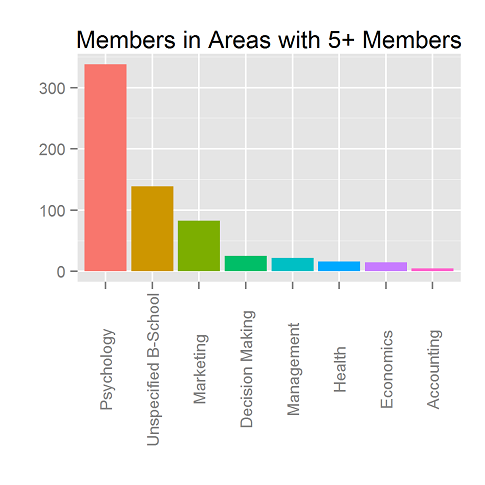
Over the next two posts, we’ll look at the membership of SJDM, the Society for Judgment and Decision Making.
Next week, we’ll break down the membership by region, country, and state.
This week, we look at where our members come from in terms of departments. To make the plot above, we had to do a fair amount of recoding, so results are approximate.
R code is below. You can download some anonymized member information here. Save it to your R working directory to proceed.
R CODE TO REPRODUCE THIS FIGURE
Filed in
Books
 Subscribe
Subscribe to Decision Science News by Email (one email per week, easy unsubscribe)
WHAT WE LOOK FOR WHEN WE DECIDE
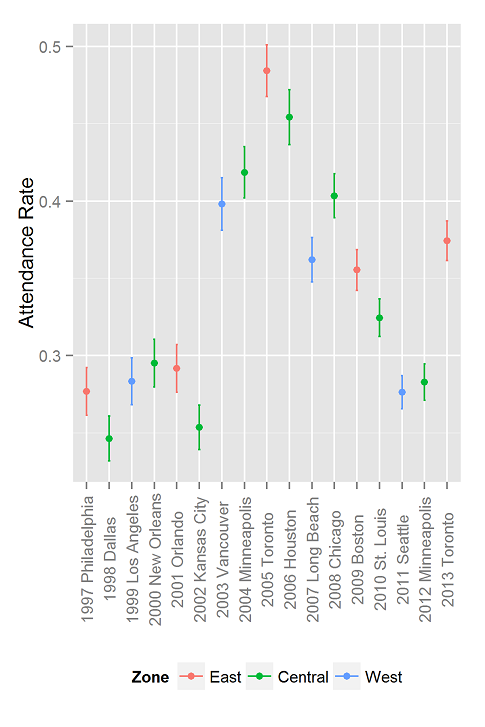
We have attended hundreds of academic conferences over the years.
We’ve seen all kinds of formats.
We’ve heard many opinions about what’s good and bad.
Here’s what we look for in an academic conference.
- Small – Fewer than 400 attendees is ideal. At large conferences, people get overwhelmed, retreat into their cliques and tend not to meet anyone new. At smaller conferences, people get to know the other attendees. After attending a small conference for a few years, you get to know a substantial proportion of the attendees. Of course, our choosing to attend small conferences only makes them bigger, but we can’t be bothered to think that many steps ahead.
- Few parallel sessions – We look for conferences that have at most 3 parallel sessions. If you sit in the back of the room at a big conference and look on, you’ll notice that people spend amazing amount of time looking through the program trying to decide what to go to next. Big conferences suffer from the cable TV problem: 57 channels and nothing on. With three tracks of quality content, people will spend less time choosing and will tend to choose well even if they choose arbitrarily (like following the person you were talking to at the coffee break).
- Selective – Selectivity predicts quality. Life’s too short to sit through bad talks. We find that conferences with acceptance rates under 30% tend to be better. Organizers should use poster sessions to enable people to come even if their presentations are not accepted.
- Short talks – With short talks, those who are interested in the research can always get more info later, and those who aren’t interested in the research don’t have to suffer. We like the 20-20-3 model: 20-minute talks (at maximum), 20 talks per track (at maximum), and three tracks (at maximum).
- Plenary and Presidential addresses take priority – If deciding whether to accept more talks or have more plenary / presidential addresses, go for the later. The big talks often have the big ideas, and give all the attendees a common experience to talk about during the conference. Having fewer talk slots will increase the average quality of the talks you do accept and will help keep the conference small.
- No presentations during meals – We don’t talk when others have the stage, but we understand why other people do. Conference are rare opportunities to connect with far-away friends and collaborators. It’s kind of cruel not to let people catch up during meals. Presidents deserve a separate session to get their ideas across. They should not have to compete with the clanking of forks and people talking. In banquet halls, half the audience can’t see the speaker anyway.
- Better yet, more meals on your own – Letting people choose where they eat keeps conference costs down and allows each attendee to spend according to his or her preferences. It’s also nice to see more of a city than just a convention hotel.
- Avoid social events that people can’t walk out of – H/T Eric Johnson. Attendees face a lot of constraints. Some are dead tired from international travel. Others need to juggle catching up with family and various groups of people in the city. The social event shouldn’t keep the attendees captive.
- Centrality – Keep in mind that the location of the conference matters when people decide to submit. Don’t forget the Europeans.
Those are our preferences. We’re open for suggestions!
By the way, registration is now open for the 2014 SJDM conference, which will be held November 21-24 in Long Beach. Early-registration (through Nov. 10) is $225 for members, $260for non-members, and $100 for students. Information on the conference can be found at www.sjdm.org — to register, visit www.sjdm.org/join.html.
Our favorite conference, the Society for Judgment and Decision Making (SJDM) Conference, is coming up soon. Our other favorite conference Behavioral Decision in Research Management (BDRM), just went down splendidly in London over the summer. We often hear people say that the SJDM and BDRM conferences are better than other psychology, decision science, consumer behavior, marketing, policy, and behavioral economics conferences. Perhaps this is due to homophily–SJDM is our favorite conference and we tend to hang out with similar others. But perhaps it is due to characteristics. We don’t have data for BDRM, but we can talk about the JDM conference. Here’s what we observe.
- JDM is small – We have put together some data on JDM attendance over the years (below). Until last year, the conference had fewer than 500 attendees. Pretty sure BDRM has always been similarly small. The Membership panel shows the number of people in the society. Attendance picked up ahead of membership in 2003. Perhaps this has something to do with Kahneman’s Nobel Prize in 2002? Correlation is not causation. We simply remember that around 2005, every grad student in Marketing started saying that they were “doing JDM”.
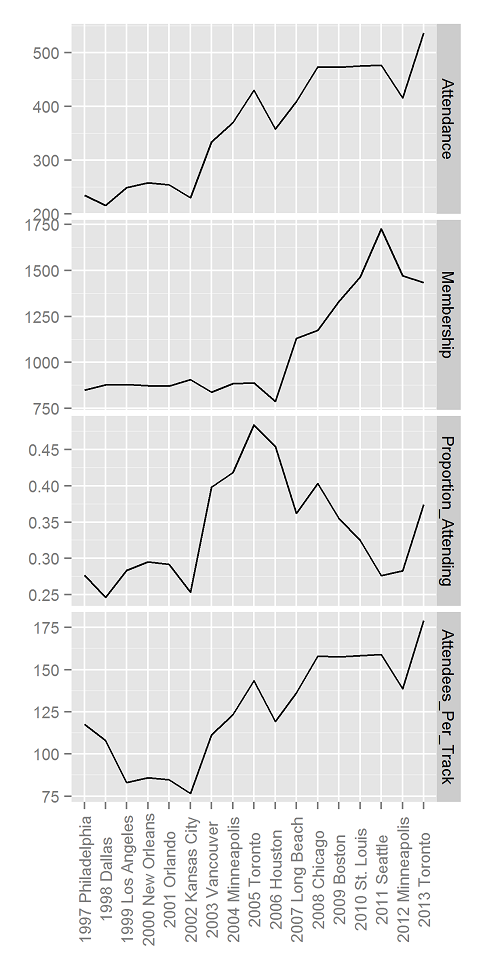
Click to Enlarge
- JDM has few parallel sessions – We went from two tracks to three in 1999. I will fight to keep it that way.
- JDM is selective – JDM routinely has acceptance rates of less than 30%, despite being a rather specialized and self-selected group of researchers. It also tends to favor people who were not accepted in the previous year. And it has a limit on the number of submissions on which someone can list themselves as a presenter. This keeps people from dominating the program.
- JDM has short talks – 20 minutes is the norm.
- JDM usually has separate Presidential and Plenary talks – Dan Ariely’s talk was the first we remember in which the President didn’t have to compete with a meal.
- JDM has meals on your own – This makes JDM an incredible value for the money. Over the last 5 years, full price registration was $200 on average, and student registration was $98! (Exclamation, not factorial.)
- JDM social events tend to be those people can walk out of – And they tend to be pretty simple. Music, dancing, drinks, done.
- JDM and location – Because JDM follows the Psychonomics Conference around, it tends to be located in major hubs that are easy to get to. The decision as to whether to break with Psychonomics comes up from time to time, but we always decide to stay. I think it’s a good move. It gives attendees the chance to attend the decision-making sessions at Psychonomics, and it saves the society the decision-making costs of figuring out where to have the conference. Yep, real decision experts consider the decision costs. Psychonomics has a policy of moving like a pendulum across the USA: East, Central, West, Central, East, …. The location does seem to affect attendance. See below and the graph at the top of this post. We think that the high attendance in Canada was because it was easier for many Europeans to get to. The estimated changes in probabilities of attending aren’t that great, so it’s probably not too bad to keep following Psychonomics around.
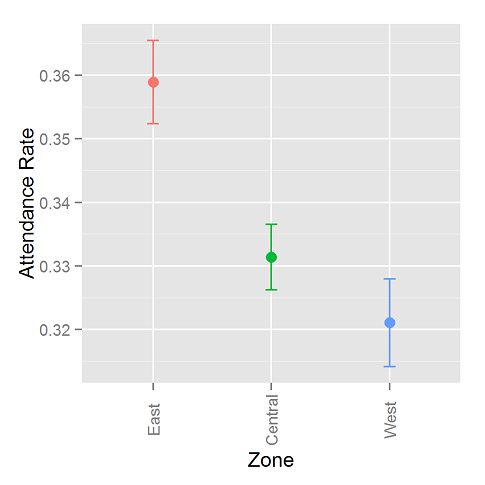
TO DO YOU OWN ANALYSES IN R
Filed in
Ideas ,
R
 Subscribe
Subscribe to Decision Science News by Email (one email per week, easy unsubscribe)
SIMPLY COUNTING OVER 44 YEARS OF DATA
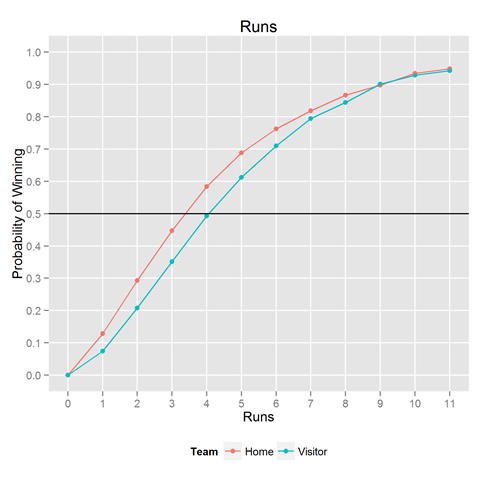
We have a father-in-law who likes baseball. Occasionally, he asks us to figure out things, which we are more than happy to do. The last request was to figure out:
If a team scores X runs, what’s the probability it will win the game?
Luckily, we had the data to solve this problem (as mentioned in past posts). Looking back over 44 years of baseball games, we looked at how often a home team scored 1 run, and counted how often the home team won. We then looked at 2, 3, 4 runs, up to 11 runs. We stop at 11 runs because we only wanted to compute relative frequencies when there’s a decent amount of data. In all our analyses here, we cut the x-axis when there are fewer than 500 observations per bin. We analyzed the visiting team’s scores separately, to see the effect of the home team advantage.
The result is shown above. If you consistently score 3-4 runs a game, you’re winning about half the games. It’s simply not good enough. Going from 2 runs a game to 6 runs a game means going from winning 25% of the time to winning 75% of the time–all the difference in the world.
Because we had the data handy, we couldn’t help but looking at the same thing for the other key statistics: hits, walks, and errors. Results below.
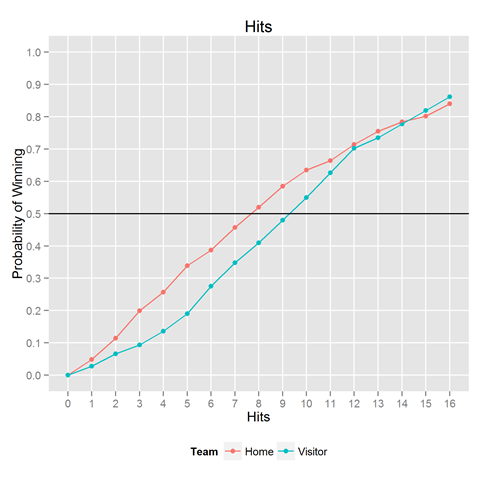
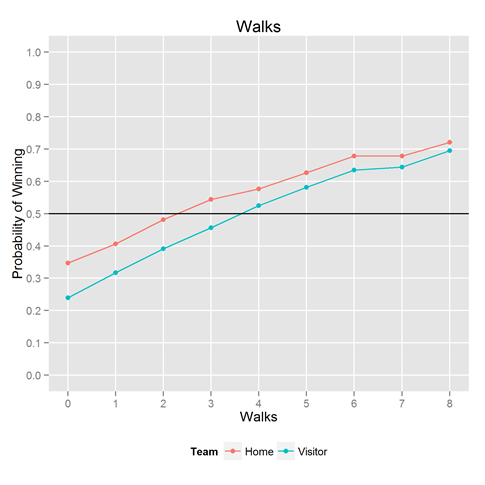
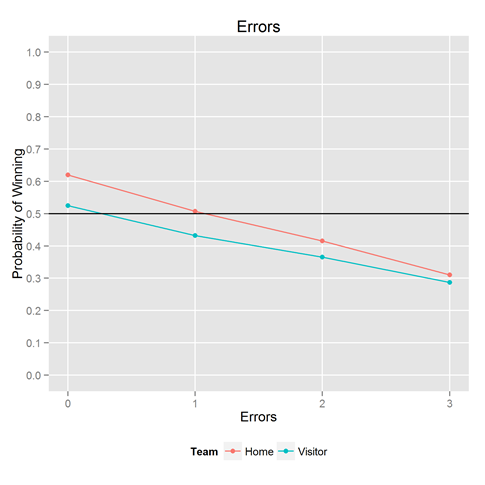
Want to play with it yourself? The R / ggplot2 code that made this plot is below. ggplot and dplyr are Hadley Wickham creations.
THE OPTIMAL DECISION SCIENCE FOOD

The question often arises: What is the best decision science food?
The answer is quite simple. It’s the Romeo and Juliet sandwich, which is an adaptation of the popular Brazilian desert “Romeu e Julieta”. We came across this delicacy quite accidentally last year and noticed a sudden reinvigoration of our decision science faculties. We then modified it slightly to make it easier for those shopping in North America and Europe by substituting cream cheese for Minas cheese. We also turned it into a sandwich, for portability.
Why is the Romeo and Juliet sandwich the perfect decision science food?
Decision science requires concentration, so its practitioners don’t want something that will put them into a food coma. As Benjamin Franklin said “Eat not to dullness“.
Decision science requires long hours at the computer, so its practitioners want something they can eat neatly at their desks.
Decision science requires satisfying multiple objectives, so its practitioners want something that delivers sweet and salty tastes at once.
Ingredients:
- 1 piece of bread
- White cheese (e.g., queso fresco, canastra, minas cheese, cream cheese)
- Guava paste (goiabada)
Directions:
1) Slice off enough guava paste to cover half a piece of bread
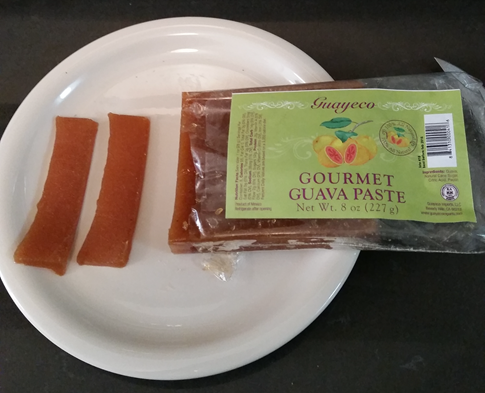
2) Cover half the piece of bread with white cheese and lay the guava paste on top of it. Cut the piece of bread in half.

3) Place the remainder bread atop the sandwich. Cut again.

4) Enjoy!
Bonus points:
1) Use an almond flour pancake instead of a piece of bread
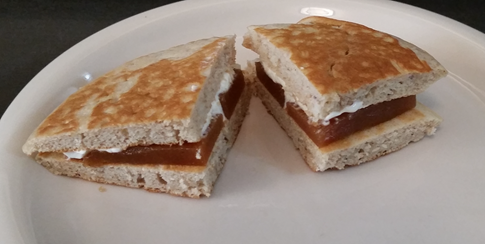
One of our offspring, despite sharing a name with Romeo and Juliet, refuses to eat the Romeo and Juliet sandwich. The reason given is a dislike of guava paste, which the child has never eaten. Neophobia, or fear of the new, has been used to characterize rats’ preferences for foods (p. 76) and childrens’ preferences for babysitters (p. 87). But please don’t let it stand in the way of your doing better decision science.
HOT COHEN’S D EFFECT SIZE VISUALIZER
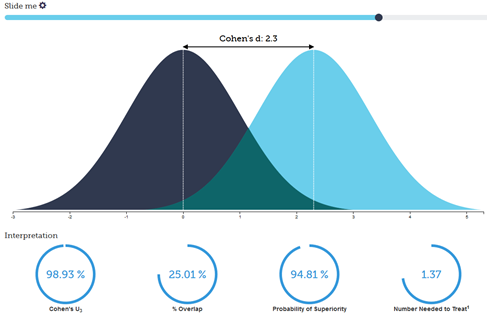
Visualization by Kristoffer Magnusson (@RPsychologist)
Social science research puts the p-value on a pedestal. The p value, or probability of the data given the null hypothesis is true, is seen as the gateway to publication, giving authors an incentive to “p hack“, or use various tricks to get p-values down below .05. And they do this despite the lord loving the .06 as much as the .05. We have written on this before:
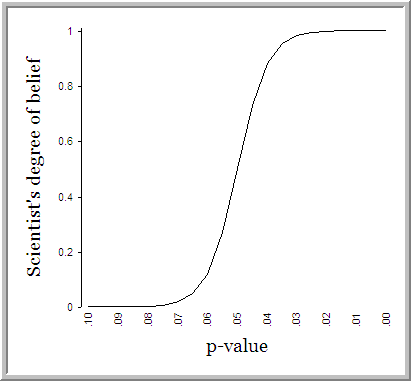
Cartoon by Decision Science News
One gripe with the p-value is that statistical significance is cheap. Most plausible hypotheses become statistically significant when the sample size is large enough. Among other things, statistical significance is a function of sample size. In the age of mTurk-scale data, attaining statistical significance is easier than ever. We have heard it said that that if you draw a line anywhere through the belly of the United States, you’ll find a significant different in height on opposite sides of the line because of the massive sample size. But it may be a puny difference.
Enter the concept of effect size. Effect size gives one a way to think about the magnitude of effects, not just the probability of the data given the null hypothesis (aka, the p-value). One popular measure of effect size, Cohen’s D, is discussed along with in the beautiful visualization pictured above. Learn more from the article It’s The Effect Size, Stupid, from which this post gets its name. And learn why you need lots of data to estimate effect sizes from our friends at Data Colada.
UNDERGRADUATE SUMMER PROJECTS AT MICROSOFT RESEARCH NYC
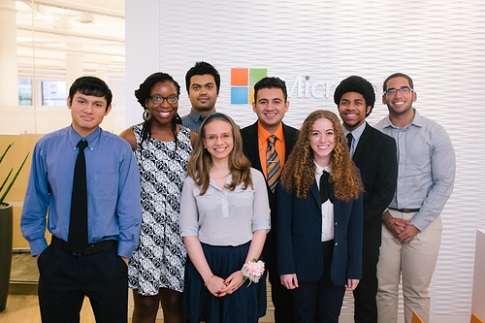
This summer, researchers at Microsoft Research NYC launched an outreach program called the Data Science Summer School (DS3 for short) an 8 week, 40 hour per week, hands-on course. It was pretty intense. Eight amazing undergrads were admitted and worked hard all summer. The program culminated in two research projects. The presentations were fantastic. We repost the slides, papers, and videos here for your learning pleasure.
Self-Balancing Bikes
By Briana Vecchione, Franky Rodriguez, Donald Hanson II, Jahaziel Guzman
Bike sharing is an internationally implemented system for reducing public transit congestion, minimizing carbon emissions, and encouraging a healthy lifestyle. Since New York City’s launch of the CitiBike program in May 2013, however, various issues have arisen due to overcrowding and general flow. In response to these issues, CitiBike employees redistribute bicycles by vehicle throughout the New York City area. During the past year, over 500,000 bikes have been redistributed in this fashion. This solution is financially taxing, environmentally and economically inefficient, and often suffers from timing issues. What if CitiBike instead used its clientele to redistribute bicycles?
In this talk, we describe the data analysis that we conducted in hopes of creating an incentive and rerouting scheme for riders to self-balance the system. We anticipate that we can decrease vehicle transportations by offering financial incentives to take bikes from relatively full stations and return bikes to relatively empty stations (with rerouting advice provided via an app). We used publicly available data obtained via the CitiBike website, consisting of starting and ending locations, times, and user characteristics for each trip taken from July 2013 through May 2014. Using this dataset, we estimated CitiBike traffic flow, which enabled us to build agent-based simulation models in response to incentives and rerouting information. By estimating various parameters under which to organize incentive schemes, we found that such a program would help to improve CitiBike’s environmentalism and increase productivity, as well as being financially beneficial for both CitiBike and its riders.
For more details, please see the paper and talk.
An Empirical Analysis of Stop-and-Frisk in New York City
By Md.Afzal Hossain, Khanna Pugach, Derek Sanz, Siobhan Wilmot-Dunbar
Between 2006 and 2012, the New York City Police Department made roughly four million stops as part of the city’s controversial stop-and-frisk program. We empirically study two aspects of the program by analyzing a large public dataset released by the police department that records all documented stops in the city. First, by comparing to block-level census data, we estimate stop rates for various demographic subgroups of the population. In particular, we find, somewhat remarkably, that the average annual number of stops of young, black men exceeds the number of such individuals in the general population. This disparity is even more pronounced when we account for geography, with the number of stops of young black men in certain neighborhoods several times greater than their number in the local population. Second, we statistically analyze the reasons recorded in our data that officers state for making each stop (e.g., “furtive movements” or “sights and sounds of criminal activity”). By comparing which stated reasons best predict whether a suspect is ultimately arrested, we develop simple heuristics to aid officers in making better stop decisions. We believe our results will help both the general population and the police department better understand the burden of stop-and-frisk on certain subgroups of the population, and that the guidelines we have developed will help improve stop-and-frisk programs in New York City and across the country.
For more details, please see the paper and talk.
Filed in
Conferences
 Subscribe
Subscribe to Decision Science News by Email (one email per week, easy unsubscribe)
ASSOCIATION FOR CONSUMER RESEARCH CONFERENCE. OCTOBER 23-26, 2014 BALTIMORE, MD
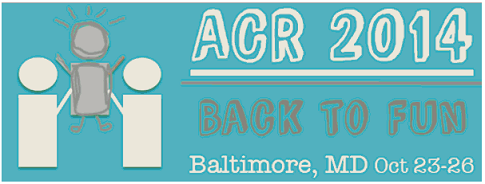
The program for the upcoming ACR conference has been published. This can be useful for figuring out if your session was accepted.
ACR 2014 Preliminary Program
While we have your attention, you can register for the conference. Price goes up after September 1, 2014!
Filed in
Jobs
 Subscribe
Subscribe to Decision Science News by Email (one email per week, easy unsubscribe)
SOCIAL SCIENCE RESEARCH ANALYST (PHD LEVEL)

The Social Security Administration’s Office of Retirement Policy (http://www.ssa.gov/retirementpolicy) is looking for a Social Science Research Analyst who will conduct and review complex research on the behavioral and psychological factors that can influence retirement behavior, work effort, and well-being.
Through written papers, oral presentations, and participation in multidisciplinary workgroups, your contributions will inform Agency executives and external policymakers as they work to improve the retirement security of our beneficiaries and the administration of our programs.
For our current vacancy announcement, open from August 1st to August 5th, visit
https://www.usajobs.gov/GetJob/ViewDetails/377087400







